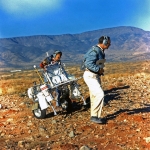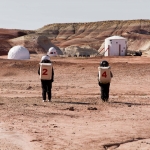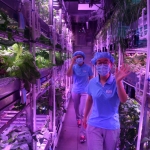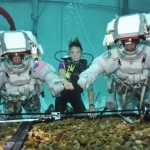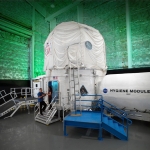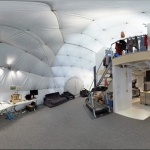An analog environment is a situation on Earth that produces effects on the body similar to those experienced in space, physically, mentally and emotionally. — NASA
SAM and many other, active space analogs listed here are noted in this Wikipedia page for Terrestrial Analogs.
BioHome
BioHome was a small facility created by NASA in the late 1980s that could support one person in a fully functional habitat. [Wikipedia]
Biosphere 2 (sealed)
From 1991-1993, the now world-famous Biosphere 2 launched an unprecedented experiment—to house eight humans in a totally sealed, self-contained ecosystem in which all air, food, and water was contained within. A great deal was learned from this experiment, about microbes, the complexity of ecosystems, human behavior, and the complexity of living outside of the massive, original biosphere we call home. The second, seven months mission 1994 enabled seven crew members to build upon the experience of the first mission, reducing pest infestation, improving food cultivar growth and productivity, and reducing CO2/O2 loss to the concrete.
Biosphere 2 now serves as a unique, large-scale experimental apparatus housing seven model ecosystems with active research by teams of multidisciplinary scientists. [website | Wikipedia]
Bios-3 (sealed)
An historic closed ecosystem research center at the Institute of Biophysics in Krasnoyarsk, Russia. Construction began in 1965 and was completed in 1972. By 1968 system efficiency had reached 99% by recycling the air, 85% by recycling water and about 50% by recycling food and nutrients. The heritage of this world-first experiment continues today with the SIRIUS analog in Moscow (below). [website]
CEEF
The CEEF (Closed Ecology Experiment Facilities) was constructed for collecting data on carbon transfer from the atmosphere to crops, livestock and humans by conducting material circulation experiments, including the habitation of humans and animals and growing crops which supply food and feed, within a closed environment. The main objective of the CEEF project involves understanding the transfer of radiocarbon in the environment via experiments using stable carbon isotopes. On the other hand, the project is also a good example demonstrating human life in ecosystem material circulation. [Semantic paper | NCBI paper | SAE paper]
Concordia Station
Concordia Station shares many stressor characteristics similar to that of long-duration deep-space missions, in particular extreme isolation and confinement. It therefore serves as a platform for research relevant to space medicine. During the winter, the crew are isolated from the outside world, having no transportation and limited communication for nine months, living a prolonged period in complete darkness. [website]
D-Mars
D-MARS – Desert Mars Analog Ramon Station is a space analog research center in Israel, in which analog astronauts go on a scientific journey of exploration that simulates an actual mission on the surface of the planet Mars.
Today, space analogs are becoming well-developed sectors of space science disciplines, used to train future human explorers, test related hardware and make space more accessible to the general public. [website]
ESA MELiSSA (sealed)
The European Space Agency has for more than a decade worked to recover food, water and oxygen from organic waste carbon dioxide and minerals, using light as source of energy to promote biological photosynthesis. MELiSSA is an assembly of processes (mechanical grinding, bioreactors, filtration, wet oxidation, etc.) aiming at a total conversion of the organic wastes and CO2 to oxygen, water and food. [website | Wikipedia]
Habitat Marte
The space analog station Habitat Marte is one of the most innovative projects in stimulating the development of skills in the aerospace area in Southern Hemisphere. We hope that from the simulation experience your participants will be interested in academic and professional careers related to the space area. [website]
HERA
Located at the NASA Johnson Space Center, HERA is a unique three-story habitat designed to serve as an analog for isolation, confinement, and remote conditions in exploration scenarios. [website]
Haughton-Mars Project (HMP)
The Haughton-Mars Project is an international multidisciplinary field research project dedicated to advancing planetary science and exploration. The HMP is centered on the scientific study of the Haughton meteorite impact crater and surrounding terrain on Devon Island, High Arctic, viewed as a planetary analog, in particular for the Moon and Mars. [website]
HESTIA
NASA’s Human Exploration System Test-bed for Integration and Advancement (HESTIA) at the Johnson Space Center is a 20-foot cylindrical pressure chamber that supported 30-, 60-, and 90-day human closed-loop ECLSS testing in the 1990s. Today HESTIA functions as a human-rated vessel evaluating ECLSS and in-sutu resource utilization (ISRU) technologies. [website]
Integrated Lunar-Martian Analog Habitat
Students at the University of North Dakota designed, constructed, and operate ILMAH, a pressurized habitat roughly the same volume as the International Space Station, or the size of a 747 airliner. The ILMH has five modules: a core module for eating and sleeping, a plant production module, an exercise module, a geology and microbiology lab module, and an EVA module with workshop.
As of 2019, ILMAH has run seven missions complete with EVAs in mock space suits. [website] | [blog]
Lunar Palace I (sealed)
Developed by the Beijing University of Aeronautics and Astronautics, the first Lunar Palace 1 multi-crew, closed integrative bioregenerative life support systems experiment was carried out from February through May 2014. The results show that environmental conditions as well as the gas balance between O2 and CO2 in the system were well maintained during the 105-day experiment. A second experiment ran for 370 days in 2017-18. [Space.com | Wikipedia]
LunAres
LunAres Research Station is an analog research station for manned space mission simulation, located at the post-military airport in Poland. The station can hold a Lunar and Martian 2 weeks mission for a 6-person crew. The facility provides space and infrastructure for complex research on the impact of long-term extra-terrestrial human presence. [website]
Mars Desert Research Station (MDRS)
The Mars Desert Research Station (MDRS), owned and operated by the Mars Society, is a space analog facility in Utah that supports Earth-based research in pursuit of the technology, operations, and science required for human space exploration. The relative isolation of the facility allows for rigorous field studies as well as human factors research. Crews carry out their mission under the constraints of a simulated Mars mission, 2-3 weeks in duration. MDRS is surrounded by a landscape that is a geologic Mars analog, offering opportunities for rigorous field studies as they would be conducted during an actual space mission. [website | Wikipedia]
NEEMO (sealed)
NASA’s NEEMO brings astronauts, engineers, and scientists into Aquarius, the world’s only undersea research station, for up to three weeks at a time. The Aquarius habitat and its surroundings provide a convincing analog for space exploration. Here equipment, tools, and techniques are tested in challenging conditions. [website]
SAM at Biosphere 2 (regulated air flow or sealed)
A Space Analog for the Moon and Mars (SAM) is a hermetically sealed habitat located at the renowned University of Arizona Biosphere 2. SAM integrates the Biosphere 2 prototype Test Module greenhouse with an adjacent workshop, kitchen, common area and living quarters with support for 1-4 inhabitants from days to months. SAM integrates a CO2 scrubber, airlock, indoor and outdoor Mars yard, pressure suits, closed greenhouse with controlled lighting, humidity, heating and cooling. The Mars yard will include varied terrain, a massive synthetic lava tube with skylight for other-world cave exploration, and a reduced gravity simulator to provide the experience of exploring on foot in lower gravitational fields. [website | Wikipedia]
SIRIUS (sealed)
The SIRIUS (Scientific International Research In a Unique terrestrial Station) missions are the first time NASA’s Human Research Program (HRP) partners with Russia’s IBMP Ground-based Experimental Complex (NEK) to conduct a series of analog missions. The NEK is an analog platform with multifunctional experimental modules capable of accommodating from 3 to 10 crew members. All hermetic chambers are equipped with autonomous life support systems controlled by an executive system that forms a habitat with specified parameters (including ventilation and air conditioning system, atmospheric purification, gas analysis and support for certain parameters of pressure, temperature, humidity and gas composition), as well as provides water supply, sewerage, electricity, electric lighting, video surveillance and fire extinguishing systems. Control of the experiment and all NEK systems, as well as monitoring and control of the crew and environmental parameters is carried out from the Mission Control Center of the experiment. [website at NASA | website at Russian Academy of Sciences]
A list of Mars analogs at Wikipedia | A list of analogs funded and used by NASA


